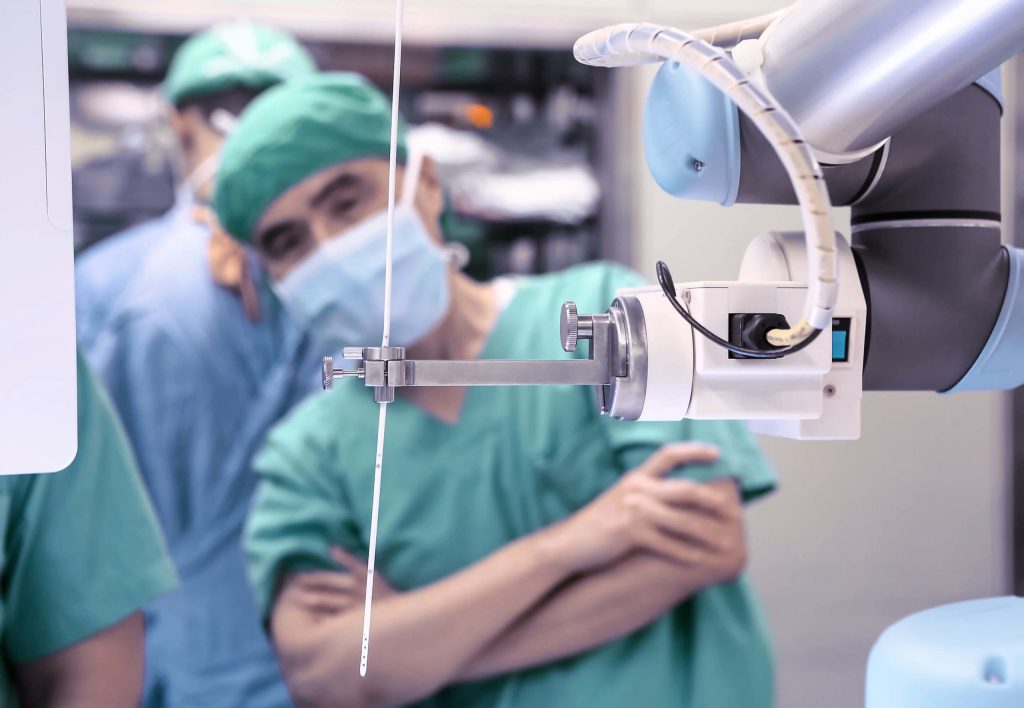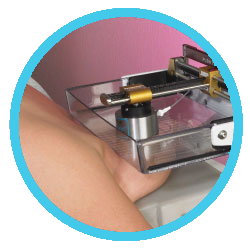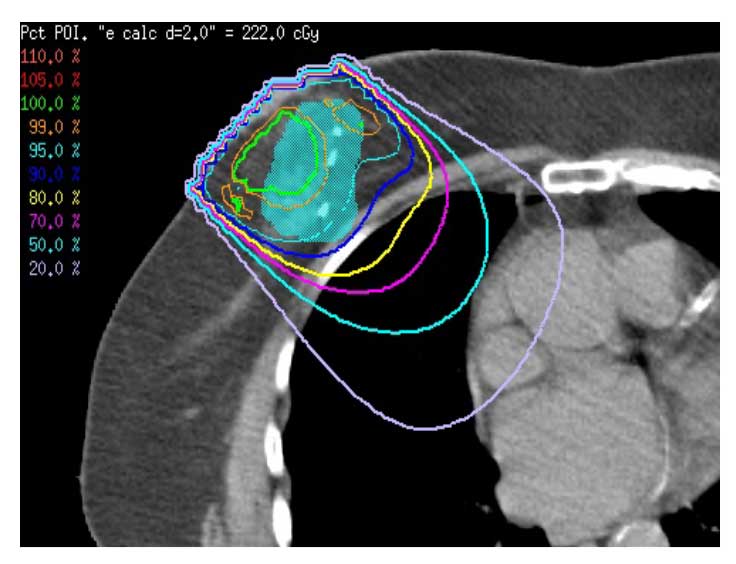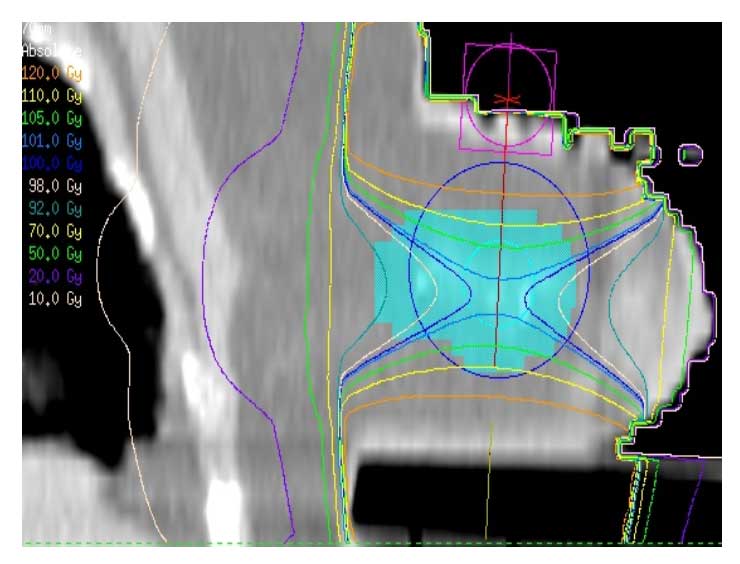AccuBoost Non-Invasive Breast Brachytherapy for APBI
Accelerated Partial Breast Irradiation (APBI) with Non-Invasive Breast Brachytherapy. AccuBoost’s targeted non-invasive radiation therapy for APBI has many benefits for early-stage breast cancer patients. AccuBoost, also known as Non-Invasive Image-Guided Breast Brachytherapy (NIBB), an important feature of the AccuBoost Technique for Accelerated Partial Breast Irradiation (APBI) is that the patient can receive treatment EITHER two times a day for 5 days OR once a day for 10 days. Additionally, not having a balloon or catheter penetrating the skin as used in intracavitary or interstitial breast brachytherapy approaches, eliminates indwelling device-related complications such as infection.
Many treatment centers refer to the treatment as “The AccuBoost Procedure”, “The AccuBoost Technique”, “Non-Invasive, Image Guided Breast Brachytherapy” sometimes abbreviated as NIBB or NIIGBB, or simply as “AccuBoost.”
NaoTrac Neurosurgical Navigation Robot
The First Autonomous Neurosurgical Navigation Robot
NaoTrac, the Neurosurgical Navigation Robot, merges high-precision technology and surgeons’ experience to improve accuracy and outcome by streamlining surgical procedures and improving the learning curve equipped with Al, Machine Vision, and Robot-Assisted Surgery. Surgical navigation with non-contact registration, preoperating planning preparation, and choosing the surgery pathway with a 3D vision for precise anatomical location. The unique autonomous procedure allows the surgeon to plan and let NaoTrac act as his assistant.


NaoTrac Robotic Technology
NaoTrac is the first Autonomous Neurosurgical Navigation Robot, which was developed by the Brain Navi team. The main goal of innovating NaoTrac is to assist the surgeon in having an alternative neurosurgery assistant for high precision. NaoTrac received more than 18 patents in technology, innovation awards, and currently in clinical trials.
Robot-assisted Neurosugery
- The robot’s arm automatically inserts the tools to the exact pre-defined position of the lesion
Instrument Recognition
- Accurately registers the spatial information of a common surgical instruments
- Precise real-time 3D trace of the registered surgical instrument with the movement of the robotic arm
- No need to measure manually surgical instruments manually
Surface Mapping Auto Registration Technology
- It locates the patient and drives the robot to the best position for the acquisition of the patient’s facial landmark
- Matches the patient’s face automatically, saving substantial time
Intended Use for Cranial Surgical Procedures
Within the increasing demand for minimally invasive surgery, the neuro-navigation is a standard in neurosurgery worldwide. Nowadays, most of the navigation system uses the type of “vision-based optical tracking systems” during the registration step. Image-guided surgery is used for intra-operative navigation assistance for neurosurgical problems. However, it does require a specific space between the device cameras, the probe, and the microscope to remain unobstructed. Brain Navi Biotechnology innovated the “Autopilot” neurosurgical navigation robot, NaoTrac. With the combination of the robotic technology, Artificial Intelligence and Machine Vision, it can assist in the surgery like Biopsy, Deep Brain Stimulation (DBS), SEEG, endoscopic surgery, and EVD in the future.
Human Clinical Trials
On 7th November 2018, NaoTrac performed its First-in-Human trial at Hualien Tzu-Chi Medical Center performing external ventricular drainage (EVD) on a hydrocephalus patient. NaoTrac implemented the EVD tube in just seconds, and a post-operative CT showed the tube was placed in the exact location, which the surgeon had planned before the surgery. NaoTrac has completed 15 clinical trial cases in Taiwan medical center; all the results were good to perfect with high precision.
Neurosurgeon Expert Feedback
“Using NaoTrac to perform EVD reduces anesthesia time, but it also improves the patient’s well-being through less invasive interventions. Most importantly, it has increased the degree of accuracy of the surgery to 1mm to 2mm,” said Shinn-Zong Lin, M.D. PhD., Superintendent of Hualien Tzu-Chi Medical Center. Ph.D. Dr. Lin also mentioned that “In the fields of immunotherapy, cell transplant, microchip implantation, etc., a high degree of accuracy is required. Therefore, NaoTrac not only executes EVD or tumor resection, but it also has the potential to collaborate with further fields.”
Patient devotion
Brain Navi robotic surgery helps enhance preoperative accuracy and rapid recovery for patients.

Accurate Targeting
The mammographic imaging allows direct visualization of the target within the breast rather than relying on any external references for field localization.
AccuBoost for Boost Dose of Whole Breast Irradiation (WBI)
With traditional WBI boost, often the breast is imaged only once or twice via CT to establish the target and treatment plan for the entire course of therapy. With typical en-face or photon boost, neither the breast nor the patient is immobilized leading to potential targeting uncertainties. When the AccuBoost Technique is used to deliver the Boost dose, the breast is imaged each and every day and treatment is based on the target within the breast as seen in that image, providing confidence that the treatment is being delivered to the desired target.
Accurate Targeting
Immobilizing the breast in this non-invasive approach, allows the radiation oncologist to identify the target with high confidence. Using daily mammographic images provides excellent visualization of the target within the breast for dose delivery and does not rely on external landmarks or special patient setup techniques like breath gate and hold.



Sparing Dose To Healthy Tissues
Rather than delivering radiation directed at the chest wall as in a traditional en-face electron Boost, the dose is delivered parallel to the chest wall. When this is combined with breast immobilization, shielded tungsten applicators and a 4-field box approach, the dose of radiation to healthy tissues and organs like the heart, lungs, skin and chest wall are reduced. Published reports indicate a substantially smaller PTV for patients with the AccuBoost Technique as compared to electrons as well as reduced dose to other structures.
